From Design to Delivery: The Journey of Aluminium Profile Manufacturing
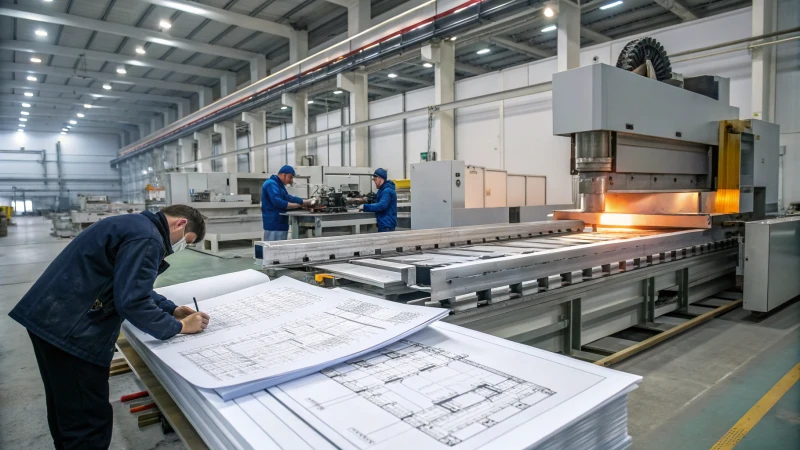
The journey of aluminium profile manufacturing is an intricate dance of design, precision, and innovation.
Aluminium profile manufacturing begins with detailed design specifications and culminates in high-quality finished products ready for delivery. This process involves several key stages, including initial design, mould making, extrusion, machining, surface treatment, quality control, and packaging.
While this overview offers a glimpse into the aluminium profile manufacturing process, understanding each phase in detail can help businesses optimize their procurement and production strategies. Dive deeper into each stage to uncover industry secrets and tips for ensuring quality and efficiency.
Extrusion is the first step in aluminium profile manufacturing.False
Extrusion follows design and mould making in the manufacturing process.
Quality control occurs before packaging in aluminium manufacturing.True
Quality control ensures products meet standards before they are packaged.
How Important is the Initial Design Phase in Aluminium Profile Manufacturing?
The initial design phase is pivotal in aluminum profile manufacturing, setting the tone for functionality, efficiency, and cost-effectiveness. Neglecting this phase can lead to costly complications and production delays.
The initial design phase in aluminum profile manufacturing is crucial as it ensures that profiles meet functional requirements and optimize production efficiency. Effective collaboration with suppliers can prevent costly complications.

Understanding the Role of Initial Design
In aluminum profile manufacturing, the initial design phase plays a critical role. It involves translating functional requirements into technical specifications. This stage determines how efficiently a profile can be produced and
its suitability for its intended application. Working closely with experienced suppliers during this phase is essential to
streamline the manufacturing process and avoid pitfalls.
Collaboration with Suppliers
The design phase requires close collaboration between clients and suppliers. Suppliers often bring a wealth of experience
in optimizing designs for manufacturability. They can provide valuable insights into minimizing complexity without sacrificing
functionality. For example, simplifying design elements can significantly reduce production costs1 by decreasing mould development time and material waste.
Balancing Aesthetics and Practicality
While an aesthetically pleasing design might seem ideal, it can lead to challenges in manufacturing. Overly complex designs may increase mould costs and prolong production timelines. It’s important to strike a balance between visual appeal
and practicality, ensuring that the design remains feasible for efficient production. Suppliers can guide designers by suggesting
alternative solutions that maintain aesthetic value while enhancing manufacturability.
| Design Consideration | Impact on Manufacturing |
|---|---|
| Complexity | Higher mould costs |
| Material Type | Influences extrusion process |
| Precision Requirements | Affects CNC machining time |
Addressing Design Challenges Early
Addressing potential design challenges early in the process can prevent future complications. Issues such as material compatibility, structural integrity, and thermal expansion need careful consideration during the initial design phase. By evaluating these factors in advance, designers can create profiles that perform reliably under various conditions. This foresight also aids in reducing unexpected manufacturing delays2.
Importance of Prototyping
Prototyping is another crucial aspect of the design phase. It allows for testing and refining designs before full-scale production. This step helps in identifying potential issues and making necessary adjustments to ensure the final product meets all specifications. Collaborating with suppliers who offer prototyping services can enhance the efficiency and effectiveness of the design process, providing a clear roadmap from concept to production-ready designs.
Long-term Benefits of a Robust Design Phase
Investing time and resources in the initial design phase pays off in the long run. A well-conceived design not only optimizes manufacturing but also enhances product performance and longevity. This phase lays the foundation for innovation and continuous improvement, enabling manufacturers to deliver high-quality aluminum profiles that meet diverse industry demands. With a strong focus on initial design, manufacturers can achieve competitive advantages3 by reducing costs, improving quality, and increasing customer satisfaction.
Initial design affects production efficiency.True
The design phase determines how efficiently a profile can be produced.
Complex designs reduce production costs.False
Complex designs increase mould costs and prolong production timelines.
What Are the Key Steps in Mould Making and Trial Production?
Mould making and trial production are crucial in manufacturing, ensuring precision and quality. But what exactly are these steps? Let’s break down this essential process.
Mould making involves designing, creating, and testing a mould to ensure it meets production standards. Trial production uses this mould to produce small batches, allowing for adjustments before mass production begins.
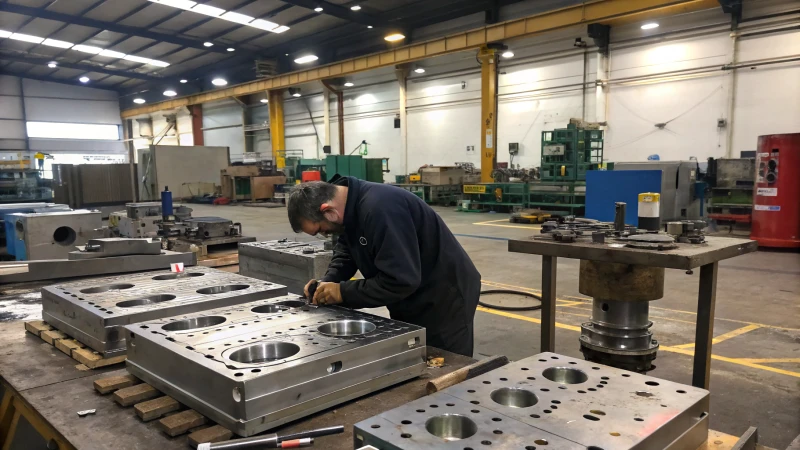
Step 1: Design and Development
The initial step in mould making is designing. Engineers collaborate with designers4 to create a blueprint that meets the specifications of the final product. This stage requires precision as the mould dictates the shape and features of the final products.
| Design Elements | Considerations |
|---|---|
| Material Type | Durability |
| Dimensions | Precision |
| Surface Finish | Aesthetics |
Step 2: Mould Fabrication
Once the design is approved, fabrication begins. Moulds are crafted using materials like steel or aluminum, chosen for their strength and heat resistance5. Advanced techniques like CNC machining are employed for high precision. Fabrication time varies depending on complexity.
Step 3: Trial Production
Before full-scale production, a trial run is conducted. This involves using the mould to produce a small batch of products. The trial phase helps identify any defects or issues in the mould design. Adjustments are made accordingly to ensure consistency and quality in mass production. This step is critical to avoid costly mistakes later.
Step 4: Testing and Quality Assurance
After trial production, rigorous testing is conducted on the produced samples. This includes checking for dimensional accuracy, material integrity, and surface quality. Quality assurance teams ensure the mould meets all required standards before moving on to full-scale production. Testing methodologies6 are often tailored to specific industry needs to ensure optimal results.
Mould making and trial production are foundational in manufacturing, ensuring that final products are made with precision and meet quality standards. Each step—from design to testing—plays a vital role in determining the success of the production process.
Design stage requires collaboration between engineers and designers.True
Engineers and designers work together to create a precise blueprint.
Moulds are always made from plastic for durability.False
Moulds are typically made from steel or aluminum for strength.
Why is CNC Machining Crucial in the Aluminium Extrusion Process?
Discover how CNC machining elevates aluminium extrusion by ensuring precision and efficiency, vital for high-quality, durable components. Dive into its key role in modern manufacturing processes.
CNC machining is crucial in aluminium extrusion as it enhances precision, efficiency, and customization. This technology enables the production of complex and precise components, which are essential for various industrial applications.
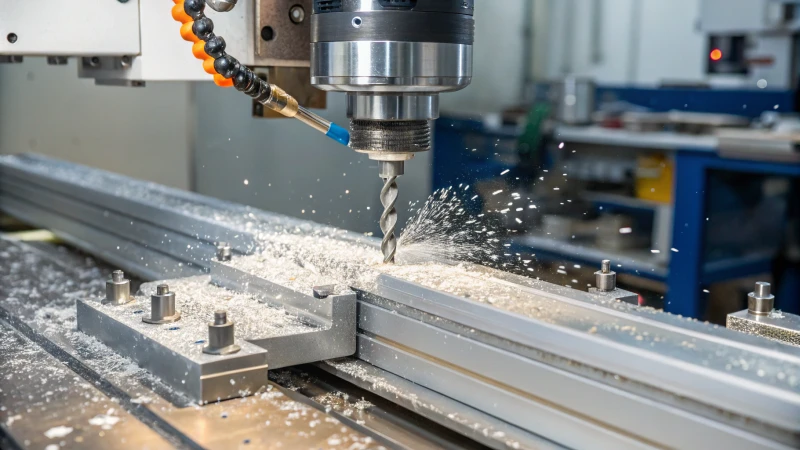
Understanding CNC Machining
CNC (Computer Numerical Control) machining is an automated control system for machine tools like drills, lathes, and 3D printers. It uses computers to control these machines, offering unparalleled precision and efficiency. The significance of CNC machining in the aluminium extrusion process7 lies in its ability to enhance production accuracy.
Enhanced Precision and Efficiency
In the aluminium extrusion process, CNC machining ensures that every profile meets exact specifications. The precision offered by CNC machines minimizes human error, thus reducing waste and increasing output quality. This level of accuracy is vital for industries demanding high precision, such as aerospace and automotive.
| Benefits of CNC Machining | Description |
|---|---|
| Precision | Achieves tight tolerances and accurate dimensions. |
| Efficiency | Automates processes, reducing manual intervention. |
| Customization | Easily adapts to complex designs and specifications. |
Customization Capabilities
CNC machining allows for high customization in aluminium extrusion. Manufacturers can quickly adapt to new designs or changes in specifications without extensive retooling, saving time and costs. For example, a specialized component8 for an automobile can be easily modified to fit different models without additional tooling.
Integration with Modern Technologies
CNC machines can be integrated with CAD (Computer-Aided Design) and CAM (Computer-Aided Manufacturing) software, allowing seamless transition from design to production. This integration facilitates quicker prototyping and testing phases, which is critical for innovation-driven industries like electronics and consumer goods.
Sustainability Benefits
Incorporating CNC machining in aluminium extrusion can lead to more sustainable production practices. By minimizing material waste and energy consumption, it supports eco-friendly manufacturing goals. This approach aligns with the growing demand for sustainable business practices across industries.
These aspects highlight why CNC machining is indispensable in modern aluminium extrusion processes, driving advancements in precision, efficiency, and sustainability.
CNC machining reduces material waste in aluminium extrusion.True
CNC machining's precision minimizes errors, reducing waste and supporting sustainability.
Manual machining offers more efficiency than CNC in extrusion.False
CNC automates processes, reducing manual intervention and increasing efficiency.
How Do Surface Treatments Enhance Aluminium Profile Durability?
Aluminium profiles are popular in many industries for their lightweight and versatile properties. But, how can their durability be enhanced to withstand harsh conditions?
Surface treatments enhance aluminium profile durability by improving corrosion resistance, wear protection, and aesthetic appeal. Methods like anodizing and powder coating create protective layers, extending the lifespan of aluminium profiles in various environments.
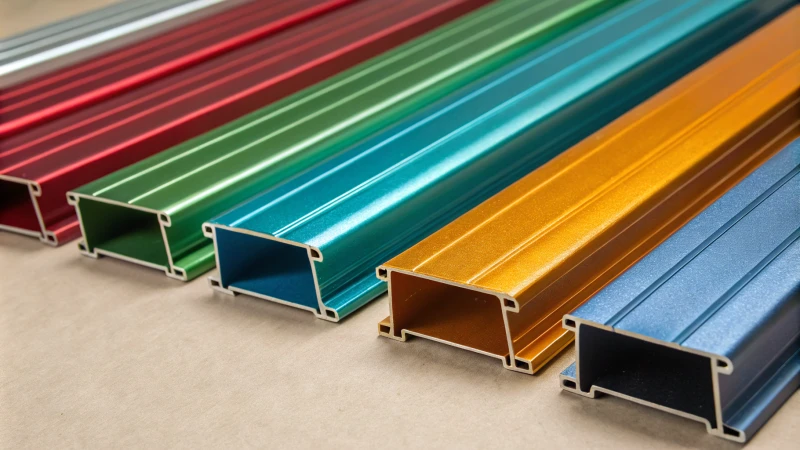
Understanding Surface Treatments
Surface treatments are vital in enhancing aluminium profile durability. They act as a protective shield against environmental and mechanical stresses. Common techniques include anodizing9, powder coating, and electrophoresis. Each offers unique benefits tailored to specific needs.
Anodizing: The Go-To Solution
Anodizing is an electrochemical process that thickens the natural oxide layer on aluminium. This method enhances corrosion resistance, making it ideal for outdoor applications. It also allows for dyeing, adding a color finish without sacrificing durability.
| Benefits of Anodizing | Description |
|---|---|
| Corrosion Resistance | Protects against rust and wear. |
| Aesthetic Appeal | Offers a range of color options. |
| Eco-Friendly | Non-toxic and recyclable process. |
Powder Coating: Versatile and Protective
Powder coating involves applying a dry powder to the aluminium surface, which is then cured under heat. This method provides a thick, uniform finish that resists chipping and scratching. It’s suitable for both indoor and outdoor applications due to its robust nature.
- Durability: Creates a tough layer resistant to abrasions.
- Color Variety: Wide range of colors available.
- Environmentally Friendly: Low VOC emissions compared to liquid paints.
Electrophoresis: For Specialized Applications
Electrophoresis is less common but valuable in specialized industries like automotive and electronics. This method immerses the aluminium in a bath where electrically charged particles coat the surface, providing a smooth, even finish that resists chemical damage.
- Applications: Used where precise coating is crucial.
- Advantages: Excellent adhesion and uniform thickness.
Choosing the right treatment depends on specific requirements like exposure conditions and desired aesthetic outcomes. For instance, anodizing10 may be preferred for marine environments due to its superior corrosion resistance. Meanwhile, powder coating might be ideal for decorative applications due to its color versatility.
For a detailed overview of the benefits of each treatment and guidance on selecting the best option for your needs, consider exploring resources on aluminium surface treatment techniques and industry best practices.
Anodizing processes11 are particularly noteworthy for their ability to withstand challenging environments, enhancing both durability and aesthetic appeal.
Anodizing improves aluminium's corrosion resistance.True
Anodizing thickens the oxide layer, enhancing resistance to corrosion.
Powder coating is unsuitable for outdoor use.False
Powder coating provides a robust finish, ideal for outdoor use.
What Quality Control Measures Ensure Top-Notch Aluminium Profiles?
Ensuring top-quality aluminium profiles involves stringent quality control measures across the manufacturing process. These practices are crucial to meet industry standards and fulfill customer expectations for durability and precision.
Quality control in aluminium profiles involves systematic checks at each production stage, including design verification, extrusion monitoring, surface treatment inspection, and final product testing to ensure compliance with technical standards.
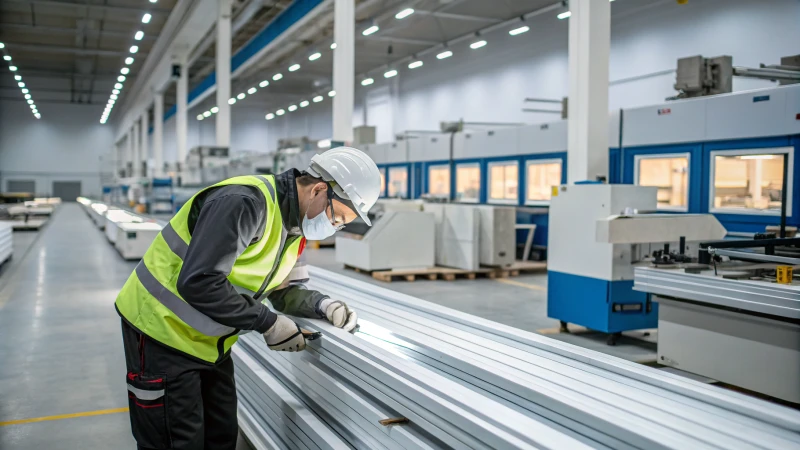
Design Verification and Compliance
The journey begins with a detailed design verification12 process. This step involves confirming that the initial designs align with both functional and aesthetic requirements. At this stage, engineers work closely with clients to refine drawings and specifications. Detailed checks ensure that designs are realistic for production, avoiding potential issues down the line.
| Design Aspect | Quality Measure |
|---|---|
| Dimensions | Precision CAD software |
| Materials | Material compatibility |
| Aesthetics | Design feasibility studies |
Extrusion Process Monitoring
During extrusion, maintaining precise temperature and pressure is paramount. This is where real-time monitoring systems13 come into play, allowing operators to adjust variables to maintain quality. Automated sensors track extrusion speed and profile uniformity, ensuring that each profile adheres to strict dimensional tolerances.
Surface Treatment Inspection
Surface treatments like anodizing or powder coating require rigorous inspection. This involves checking for uniform coating thickness and verifying that the treatment enhances both appearance and durability. Quality teams employ visual and chemical tests to ensure the surface treatment meets customer and environmental standards.
Final Product Testing
Before dispatch, each batch undergoes comprehensive testing. This includes mechanical tests to verify tensile strength and durability, alongside dimensional checks using CNC machinery14. Random sampling often includes third-party inspections to certify quality independently.
Industry Certifications
Obtaining certifications such as ISO 9001 is a testament to a manufacturer’s commitment to quality. These certifications require ongoing audits and adherence to rigorous standards, providing assurance to clients about the consistent quality of their aluminium profiles.
By implementing these quality control measures, manufacturers not only enhance product reliability but also build trust with clients seeking premium aluminium profiles for various applications. Consistent monitoring and adherence to best practices are crucial for producing aluminium profiles that meet the highest industry standards.
Design verification ensures aesthetic requirements are met.True
The design verification process confirms alignment with aesthetic needs.
ISO 9001 certification is not related to quality assurance.False
ISO 9001 certification demonstrates commitment to quality standards.
Conclusion
Aluminium profile manufacturing involves design, mould making, extrusion, machining, surface treatment, and quality control to ensure high-quality products for various industries.
-
Discover strategies to minimize production costs through effective design optimization. ↩
-
Learn about frequent causes of manufacturing delays and how to prevent them. ↩
-
Understand how investing in initial design can offer a competitive edge. ↩
-
Understanding this collaboration highlights how design impacts mould functionality and efficiency. ↩
-
Learn about different materials that enhance durability and heat resistance of moulds. ↩
-
Explore various testing methods that ensure product quality and compliance with standards. ↩
-
This link explores how CNC machining impacts the precision and quality of aluminium extruded products. ↩
-
Discover how CNC machining facilitates the customization of components for various automotive applications. ↩
-
Learn more about anodizing, a process that enhances corrosion resistance and adds color options to aluminium profiles. ↩
-
Discover why anodizing is ideal for protecting aluminium profiles used in marine settings against corrosion. ↩
-
Explore the numerous benefits of anodizing, including improved durability and aesthetic enhancements. ↩
-
Design verification ensures that the initial concepts align with production capabilities, preventing costly redesigns later. ↩
-
Real-time monitoring enhances precision by allowing immediate adjustments during extrusion, ensuring consistent quality. ↩
-
CNC machinery ensures precision in dimensions, vital for maintaining product specifications. ↩



